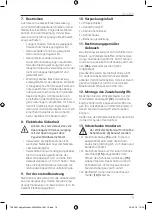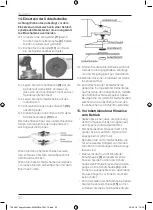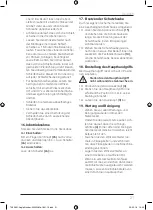
English
8
c. Always use the protective hood
intended for the kind of attachment
you are using. The protective hood
must be securely attached and be
adjusted in such a way that the high-
est possible degree of safety is
achieved, e.g. the smallest possible
part of the spinning attachment point-
ing to the operator is free.
The protec-
tive hood is intended to protect the
operator from flying debris, fragments
of a fractured disc and accidental con-
tact with the attachment.
d. Use discs only for the purpose they
are intended for by the manufacturer.
Never use the side of a cutting disc for
grinding.
Cutting discs are intended for
cutting only. Lateral forces may cause
fracture.
e. Always use undamaged flanges of the
correct size and shape for your cutting
disc.
The correct flanges support the
disc and reduce the risk of a disc frac-
ture. Flanges for cutting discs can differ
from those for grinding discs.
f. Do not use worn-down discs from
larger electric tools.
These are not
intended for the fast speeds of smaller
electric tools and may fracture.
6. Additional safety warnings spe-
cific for abrasive cutting-off
operations
Cut-off operations are only suitable
with a special protection guard
(6b)
(not included)
a. Avoid blocking the disc and do not use
excessive pressure. Do not attempt
excessively deep cuts.
Excessive loads
on the cutting disc increase the stress
and make it more prone to jamming or
blocking and increase the risk of kick-
back of fracture.
b. Do not position your body in line with
and behind the rotating wheel.
When
the wheel, at the point of operation, is
moving away from your body, the possi-
ble kickback may propel the spinning
wheel and the power tool directly at
you.
c. When wheel is binding or when inter-
rupting a cut for any reason, switch off
the power tool and hold the power tool
motionless until the wheel comes to a
complete stop. Never attempt to
remove the cut-off wheel from the cut
while the wheel is in motion otherwise
kickback may occur.
Investigate and
take corrective action to eliminate the
cause of wheel binding.
d. Do not restart the cutting operation in
the workpiece. Let the wheel reach full
speed and carefully re-enter the cut.
The wheel may bind, walk up or kick-
back if the power tool is restarted in the
workpiece.
e. Support panels or any oversized work-
piece to minimize the risk of wheel
pinching and kickback.
Large work-
pieces tend to sag under their own
weight. Supports must be placed under
the workpiece near the line of cut and
near the edge of the workpiece on both
sides of the wheel.
f. Use extra caution when making a
“pocket cut” into existing walls or
other blind areas.
The protruding wheel
may cut gas or water pipes, electrical
wiring or objects that can cause
kickback.
7. Residual risks
Even when you use this electric power tool
correctly, residual risks remain. The follow-
ing dangers may arise in connection with
the construction and application of electric
power tools, among other things:
• Lung damage if no suitable protective
dust mask is used.
• Damage to hearing if no suitable ear
protection is used.
• Damage to health resulting from hand-
arm vibrations if the electric power tool
is used over a long period of time, or is
incorrectly operated or maintained.
• Warning! These electric power tools
produce an electromagnetic field during
operation. Under certain circum-
stances, this field may impair the opera-
tion of active or passive medical
implants. In order to reduce the danger
7062851-Angle-Grinder-2200W-Ma-1801-15.indb 8
26-03-18 10:55











































